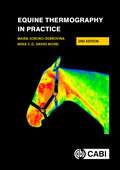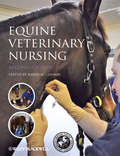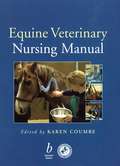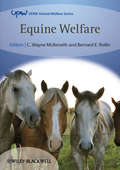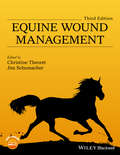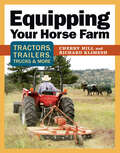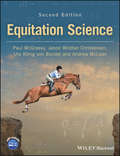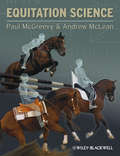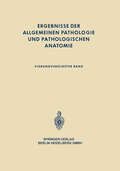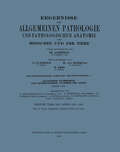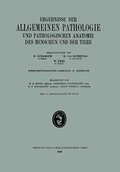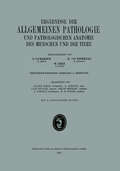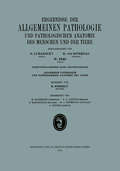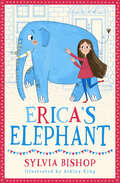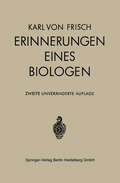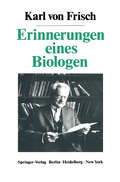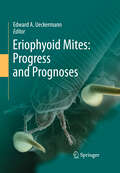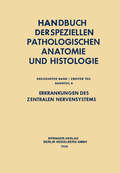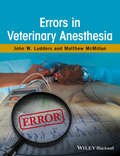- Table View
- List View
Equine Thermography in Practice
by Dr Maria Soroko-Dubrovina Mina C Davies MorelEvidence-based and yet very practical, Equine Thermography in Practice discusses how to use the tool in the diagnosis of equine musculoskeletal injuries. It covers what the user can expect to see in normal versus injured horses, giving guidelines for best practice. The book builds on the basics covering the principles of thermography, then reviews its applications in equine veterinary medicine and the role of the technique regarding equestrian athletes and rehabilitation. Fully updated throughout with new references and additional illustrative case studies, this new edition: - Covers advances made in thermography applications for rehabilitation, such as assessing the effectiveness of physical devices like lasers, magnetic therapy, shock wave therapy and cryotherapy with additional updated references. - Includes new cases and thermographic images to illustrate improvements in the technology. - Updates knowledge on thermographic imaging technology. - Extensively illustrated and thoroughly referenced, this book is indispensable for both novice and experienced practitioners using the technique, including equine veterinarians, and equine physiotherapists and body work practitioners.
Equine Veterinary Nursing
by Karen CoumbeThe breadth and depth of expertise essential for equine veterinary nursing today is provided in this definitive textbook. Thoroughly revised and updated in its second edition, and now fully illustrated in colour. This book covers the content of the ever-expanding equine nursing syllabus, while still succinctly covering all the basics that veterinary nurses specialising in other species need to know. The key subjects included are: basic equine management, medical and surgical equine nursing, nutrition, reproduction and foal care, emergency first aid, and the theory underpinning these and other important topics. Equine Veterinary Nursing Second Edition is presented in a clear and user-friendly manner, appropriate for all those involved in equine nursing. A practical approach is used throughout and procedures are illustrated with a large number of line diagrams and clinical photographs. It is an essential manual for all student and qualified equine veterinary nurses and all those involved in the care of horses. KEY FEATURES Includes a new chapter on the equine nurse’s professional responsibilities Major revisions to the chapters on diagnostic imaging and surgical nursing to reflect advances in technology and techniques All information on health and safety management updated in keeping with new regulations Authors include both vets and experienced equine nurses Endorsed by the British Equine Veterinary Association "With the increasing demands of equine practice has come the need for well trained and competent equine nurses. There have been significant improvements in and expansion of the equine Veterinary Nurse training syllabus over the past few years to meet these demands. This new and updated edition of Equine Veterinary Nursing covers all aspects of the new syllabus with well written and illustrated chapters from a wide range of knowledgable and experienced authors. The British Equine Veterinary Association is pleased to endorse this text as a 'must have' for all trainee equine veterinary nurses and their training practices." - Deidre M Carson BVSc(Syd) MRCVS Immediate Past President, BEVA
Equine Veterinary Nursing
by Karen M CoumbeThe breadth and depth of expertise essential for equine veterinary nursing today is provided in this definitive textbook. Thoroughly revised and updated in its second edition, and now fully illustrated in colour. This book covers the content of the ever-expanding equine nursing syllabus, while still succinctly covering all the basics that veterinary nurses specialising in other species need to know. The key subjects included are: basic equine management, medical and surgical equine nursing, nutrition, reproduction and foal care, emergency first aid, and the theory underpinning these and other important topics. Equine Veterinary Nursing Second Edition is presented in a clear and user-friendly manner, appropriate for all those involved in equine nursing. A practical approach is used throughout and procedures are illustrated with a large number of line diagrams and clinical photographs. It is an essential manual for all student and qualified equine veterinary nurses and all those involved in the care of horses. KEY FEATURES Includes a new chapter on the equine nurse’s professional responsibilities Major revisions to the chapters on diagnostic imaging and surgical nursing to reflect advances in technology and techniques All information on health and safety management updated in keeping with new regulations Authors include both vets and experienced equine nurses Endorsed by the British Equine Veterinary Association "With the increasing demands of equine practice has come the need for well trained and competent equine nurses. There have been significant improvements in and expansion of the equine Veterinary Nurse training syllabus over the past few years to meet these demands. This new and updated edition of Equine Veterinary Nursing covers all aspects of the new syllabus with well written and illustrated chapters from a wide range of knowledgable and experienced authors. The British Equine Veterinary Association is pleased to endorse this text as a 'must have' for all trainee equine veterinary nurses and their training practices." - Deidre M Carson BVSc(Syd) MRCVS Immediate Past President, BEVA
Equine Veterinary Nursing Manual
by Karen CoumbeEndorsed by the British Equine Veterinary Association, this book aims to cover the syllabus for the new RCVS equine veterinary nursing certificate. It covers subjects such as medical and surgical equine nursing, basic equine management and the theory underpinning these topics. It also includes chapters on nutrition, imaging and anatomy and physiology not previously well covered for the equine at a level appropriate for nurses. The approach is practical and the book is laid out in a user-friendly manner with copious illustrations.
Equine Welfare (UFAW Animal Welfare #7)
by C. Wayne McIlwraith Bernard E. RollinA rational exploration of the ethical and welfare issues in all areas of equine use. This book addresses controversial and emotive issues surrounding these iconic creatures, providing a reliable source of information to support informed debate. It will enable all those with an interest in horses and the uses they are put to gain an awareness of the problems and abuses that occur. The book draws on the expertise of a range of acknowledged leaders in equine health and welfare. The first part of the book explores general issues of the horse’s needs and nature. The second part contains chapters each covering a specific human use of horses and the abuses that arise as a result. This book is part of the UFAW/Wiley-Blackwell Animal Welfare Book Series. This major series of books produced in collaboration between UFAW (The Universities Federation for Animal Welfare), and Wiley-Blackwell provides an authoritative source of information on worldwide developments, current thinking and best practice in the field of animal welfare science and technology. For details of all of the titles in the series see www.wiley.com/go/ufaw.
Equine Welfare (UFAW Animal Welfare #8)
by C. Wayne McIlwraith Bernard E. RollinA rational exploration of the ethical and welfare issues in all areas of equine use. This book addresses controversial and emotive issues surrounding these iconic creatures, providing a reliable source of information to support informed debate. It will enable all those with an interest in horses and the uses they are put to gain an awareness of the problems and abuses that occur. The book draws on the expertise of a range of acknowledged leaders in equine health and welfare. The first part of the book explores general issues of the horse’s needs and nature. The second part contains chapters each covering a specific human use of horses and the abuses that arise as a result. This book is part of the UFAW/Wiley-Blackwell Animal Welfare Book Series. This major series of books produced in collaboration between UFAW (The Universities Federation for Animal Welfare), and Wiley-Blackwell provides an authoritative source of information on worldwide developments, current thinking and best practice in the field of animal welfare science and technology. For details of all of the titles in the series see www.wiley.com/go/ufaw.
Equine Wound Management
by Christine L. Theoret Jim SchumacherNow in its third edition, Equine Wound Management is the authoritative resource for both theoretical and practical information on the care of wounds in horses. The most comprehensive resource on managing equine wounds Organized by body region Over 750 color photographs Summaries at the beginning of each chapter and highlighted key information aid readers to rapidly find relevant information Companion website offers videos, interactive multiple choice questions and answers, case studies, and images from the book for download
Equine Wound Management: Equine Practice (The\clinics: Veterinary Medicine Ser.)
by Christine Theoret Jim SchumacherNow in its third edition, Equine Wound Management is the authoritative resource for both theoretical and practical information on the care of wounds in horses. The most comprehensive resource on managing equine wounds Organized by body region Over 750 color photographs Summaries at the beginning of each chapter and highlighted key information aid readers to rapidly find relevant information Companion website offers videos, interactive multiple choice questions and answers, case studies, and images from the book for download
Equipping Your Horse Farm: Tractors, Trailers, Trucks & More
by Cherry Hill Richard KlimeshRunning a horse farm requires acquiring, operating, and maintaining an assortment of heavy machinery. This practical guide shows you how to expertly equip your operation with trucks, trailers, tractors, and more. Learn how to compare models, select machines appropriate to your needs, troubleshoot problems, and work with attachments like loaders, disc harrows, and manure spreaders. Using the right machinery will help you work more efficiently, save you money, and leave you more time to spend with your horses.
Equitation Science: Equitation Science In Practice
by Paul McGreevy Janne Winther Christensen Uta König von Borstel Andrew McLeanA new edition of a highly respected textbook and reference in the rapidly emerging field of equitation science. Equitation Science, 2nd Edition incorporates learning theory into ethical equine training frameworks suitable for riders of any level and for all types of equestrian activity. Written by international experts at the forefront of the development of the field, the welfare of the horse and rider safety are primary considerations throughout. This edition features a new chapter on research methods, and a companion website provides the images from the book in PowerPoint.
Equitation Science
by Paul McGreevy Janne Winther Christensen Uta König von Borstel Andrew McLeanA new edition of a highly respected textbook and reference in the rapidly emerging field of equitation science. Equitation Science, 2nd Edition incorporates learning theory into ethical equine training frameworks suitable for riders of any level and for all types of equestrian activity. Written by international experts at the forefront of the development of the field, the welfare of the horse and rider safety are primary considerations throughout. This edition features a new chapter on research methods, and a companion website provides the images from the book in PowerPoint.
Equitation Science: Equitation Science In Practice
by Paul McGreevy Andrew McLeanWritten by two internationally recognised experts, Equitation Science is the first book to draw together the principles of this emerging field into a much-needed coherent source of information. The goal of equitation science is to enhance our understanding of how horses think and learn, and to use their natural behaviour to train, ride or compete with them in as fair a manner as possible. The welfare consequences of training and competing horses under different protocols are explored. Drawing on traditional and emergent techniques, this book incorporates learning theory into an ethical equine training system suitable for all levels. It also focuses on evidence-based approaches that improve rider safety. "Equitation Science is one of those rare books that is going to change the way we train and manage horses forever. It brings together a fundamental understanding of the way horses think and behave and presents a system of modern training that has the welfare of the horse at its core – it must be the foundation work for the next generation of professional and amateur riders and trainers. Riders will ride better, trainers will train better and we will have happier, healthier horses."—Wayne Channon, International Grand Prix Rider "I found this a very interesting and enlightening book. Equitation Science will help anyone involved with horses to understand them more and to be more effective in their training and education. The knowledge this brings to anyone involved with horses should help to make the horses’ lives easier and therefore allow the partnership between humans and equines to flourish."—Yogi Breisner, British Eventing Performance Manager "Equitation Science is an ambitious and thorough look at an enormous range of areas, approaches and factors concerning the training of horses. The authors have an underlying theme to their text of scientifically assessing and then also promoting the use of ethical and humane methods of horse training to increase all sport horses’ welfare and happiness within their sporting requirements. Equitation Science also provides an invaluable insight as to how and why what we do with our horses actually works."—Paul Tapner, Professional International Advanced Eventing Rider, Badminton CCI**** 2010 Winner
Equitation Science
by Paul McGreevy Andrew McLeanWritten by two internationally recognised experts, Equitation Science is the first book to draw together the principles of this emerging field into a much-needed coherent source of information. The goal of equitation science is to enhance our understanding of how horses think and learn, and to use their natural behaviour to train, ride or compete with them in as fair a manner as possible. The welfare consequences of training and competing horses under different protocols are explored. Drawing on traditional and emergent techniques, this book incorporates learning theory into an ethical equine training system suitable for all levels. It also focuses on evidence-based approaches that improve rider safety. "Equitation Science is one of those rare books that is going to change the way we train and manage horses forever. It brings together a fundamental understanding of the way horses think and behave and presents a system of modern training that has the welfare of the horse at its core – it must be the foundation work for the next generation of professional and amateur riders and trainers. Riders will ride better, trainers will train better and we will have happier, healthier horses."—Wayne Channon, International Grand Prix Rider "I found this a very interesting and enlightening book. Equitation Science will help anyone involved with horses to understand them more and to be more effective in their training and education. The knowledge this brings to anyone involved with horses should help to make the horses’ lives easier and therefore allow the partnership between humans and equines to flourish."—Yogi Breisner, British Eventing Performance Manager "Equitation Science is an ambitious and thorough look at an enormous range of areas, approaches and factors concerning the training of horses. The authors have an underlying theme to their text of scientifically assessing and then also promoting the use of ethical and humane methods of horse training to increase all sport horses’ welfare and happiness within their sporting requirements. Equitation Science also provides an invaluable insight as to how and why what we do with our horses actually works."—Paul Tapner, Professional International Advanced Eventing Rider, Badminton CCI**** 2010 Winner
Ergänzende Versuche über die Regeneration der äußeren Kiemen von Froschlarven
by Adalbert FeldottoDieser Buchtitel ist Teil des Digitalisierungsprojekts Springer Book Archives mit Publikationen, die seit den Anfängen des Verlags von 1842 erschienen sind. Der Verlag stellt mit diesem Archiv Quellen für die historische wie auch die disziplingeschichtliche Forschung zur Verfügung, die jeweils im historischen Kontext betrachtet werden müssen. Dieser Titel erschien in der Zeit vor 1945 und wird daher in seiner zeittypischen politisch-ideologischen Ausrichtung vom Verlag nicht beworben.
Ergebnisse der Allgemeinen Pathologie und Pathologischen Anatomie des Menschen und der Tiere: Einundzwanzigster Jahrgang: Ergänzungsband. I. Allgemeine Pathologie und Pathologische Anatomie des Auges
by Th. Axenfeld Arthur Birch-Hirschfeld W. Hoffmann Heinrich Jakob A. Peters R. Seefelder Paul WätzoldDieser Buchtitel ist Teil des Digitalisierungsprojekts Springer Book Archives mit Publikationen, die seit den Anfängen des Verlags von 1842 erschienen sind. Der Verlag stellt mit diesem Archiv Quellen für die historische wie auch die disziplingeschichtliche Forschung zur Verfügung, die jeweils im historischen Kontext betrachtet werden müssen. Dieser Titel erschien in der Zeit vor 1945 und wird daher in seiner zeittypischen politisch-ideologischen Ausrichtung vom Verlag nicht beworben.
Ergebnisse der Allgemeinen Pathologie und Pathologischen Anatomie des Menschen und der Tiere: Zweiundzwanzigster Jahrgang: II. Abteilung
by H. B. Hoppe Friedrich Standenath G. P. Ssacharoff Adolf PosseltDieser Buchtitel ist Teil des Digitalisierungsprojekts Springer Book Archives mit Publikationen, die seit den Anfängen des Verlags von 1842 erschienen sind. Der Verlag stellt mit diesem Archiv Quellen für die historische wie auch die disziplingeschichtliche Forschung zur Verfügung, die jeweils im historischen Kontext betrachtet werden müssen. Dieser Titel erschien in der Zeit vor 1945 und wird daher in seiner zeittypischen politisch-ideologischen Ausrichtung vom Verlag nicht beworben.
Ergebnisse der Allgemeinen Pathologie und Pathologischen Anatomie des Menschen und der Tiere: Zweiundzwanzigster Jahrgang: I. Abteilung
by Eugen Kirch A. SCHULTZ Curt Krause Oskar Seifried Adolf Posselt W. H. StefkoDieser Buchtitel ist Teil des Digitalisierungsprojekts Springer Book Archives mit Publikationen, die seit den Anfängen des Verlags von 1842 erschienen sind. Der Verlag stellt mit diesem Archiv Quellen für die historische wie auch die disziplingeschichtliche Forschung zur Verfügung, die jeweils im historischen Kontext betrachtet werden müssen. Dieser Titel erschien in der Zeit vor 1945 und wird daher in seiner zeittypischen politisch-ideologischen Ausrichtung vom Verlag nicht beworben.
Ergebnisse der Allgemeinen Pathologie und Pathologischen Anatomie des Menschen und der Tiere (Allgemeine Pathologie und Pathologische Anatomie des Auges)
by O. Lubarsch R. von Ostertag W. FreiDieser Buchtitel ist Teil des Digitalisierungsprojekts Springer Book Archives mit Publikationen, die seit den Anfängen des Verlags von 1842 erschienen sind. Der Verlag stellt mit diesem Archiv Quellen für die historische wie auch die disziplingeschichtliche Forschung zur Verfügung, die jeweils im historischen Kontext betrachtet werden müssen. Dieser Titel erschien in der Zeit vor 1945 und wird daher in seiner zeittypischen politisch-ideologischen Ausrichtung vom Verlag nicht beworben.
Eriophyoid Mites: Progress and Prognoses
by Edward A. UeckermannFourteen informative papers dealing with their DNA, species interactions, adventiveness, host specificity, potential as boi-contol agents of weeds, chemical control, behaviour, their role in fungal pathogen epidemiology, influence in forests and on ornamentals, collecting and mounting techniques and their interaction with crops are presented here. This is an extensive and valuable contribution to eriophyoid science and a must for present and future researchers in this field.
Erkrankungen des zentralen Nervensystems II: In 2 Teilen (pdf) (Handbuch der speziellen pathologischen Anatomie und Histologie #13 / 2)
by R. BielingErrors in Veterinary Anesthesia
by John W. Ludders Matthew McMillanErrors in Veterinary Anesthesia is the first book to offer a candid examination of what can go wrong when anesthetizing veterinary patients and to discuss how we can learn from mistakes. Discusses the origins of errors and how to learn from mistakes Covers common mistakes in veterinary anesthesia Provides strategies for avoiding errors in anesthetizing small and large animal patients Offers tips and tricks to implement in clinical practice Presents actual case studies discussing errors in veterinary anesthesia
